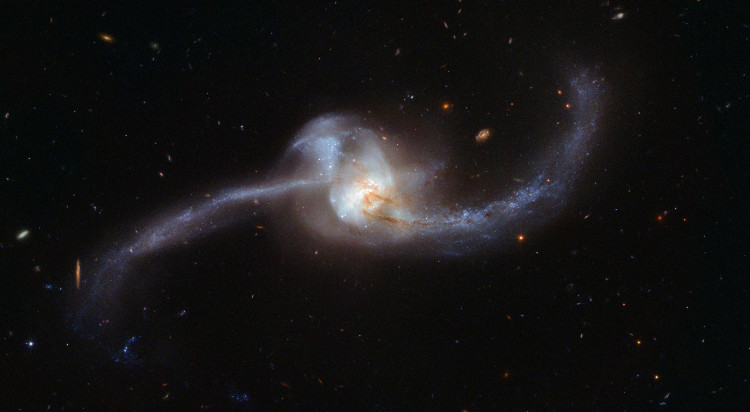The knot formed from two galaxies collided
The spiral-shaped NGC 2623 galaxy helps scientists understand more about the Milky Way collision in about 4 billion years.
Scientists obtained the unique twisting image of NGC 2623 , or Arp 243 , thanks to Space on November 14. NGC 2623 is about 250 million light-years from Earth and belongs to the Cancer constellation, according to NASA.

Galaxy NGC 2623 is the result of a large collision between two galaxies in the universe.(Photo: NASA).
This is essentially the result of a large collision between the two galaxies, creating a "cosmic knot" . The impact caused a strong effect, causing gas clouds to be compressed and stirred, a series of new stars formed.
The light blue dots in the middle are many young stars, both formed and high in temperature, and the long tail tracks of the galaxy are gas and dust clouds. Experts have discovered at least 170 hot and bright star clusters belonging to NGC 2623.
This galaxy is in the second half of the merger process. The Hubble telescope's image helps scientists visualize a part of the Milky Way's collision, the "home" of the Earth, with the so-called Tien Nu galaxy in the future.
The Milky Way can collide and merge with the Andromeda galaxy.(Video: YouTube).
Andromeda lies about 2.5 million light-years from Earth, the largest galaxy near the Milky Way. This galaxy is rushing towards Earth at a speed of 400,000 km / h. Scientists estimate that it may collide with the Milky Way after about 4 billion years. The Milky Way can transform into the same twisted shape when merged with this galaxy.
- Discover the birth of ancient galaxies
- Decoding adds a mystery of the universe
- Andromeda galaxy will destroy the Earth
- The Milky Way has no numerical date
- How have galaxies changed since the universe formed?
- The first image of the early Milky Way Strip
- Ancient galaxies are suitable for life
- The mystery of the dead galaxies
- Detected 23 galaxies formed after 800 million years of Big Bang explosion
- Detecting a group of 'ghost galaxies'
- Huge heat destroys the process of forming galaxies in the universe
- Discover 'living fossil' galaxies in the universe
 Van Allen's belt and evidence that the Apollo 11 mission to the Moon was myth
Van Allen's belt and evidence that the Apollo 11 mission to the Moon was myth The levels of civilization in the universe (Kardashev scale)
The levels of civilization in the universe (Kardashev scale) Today Mars, the sun and the Earth are aligned
Today Mars, the sun and the Earth are aligned The Amazon owner announced a secret plan to build a space base for thousands of people
The Amazon owner announced a secret plan to build a space base for thousands of people